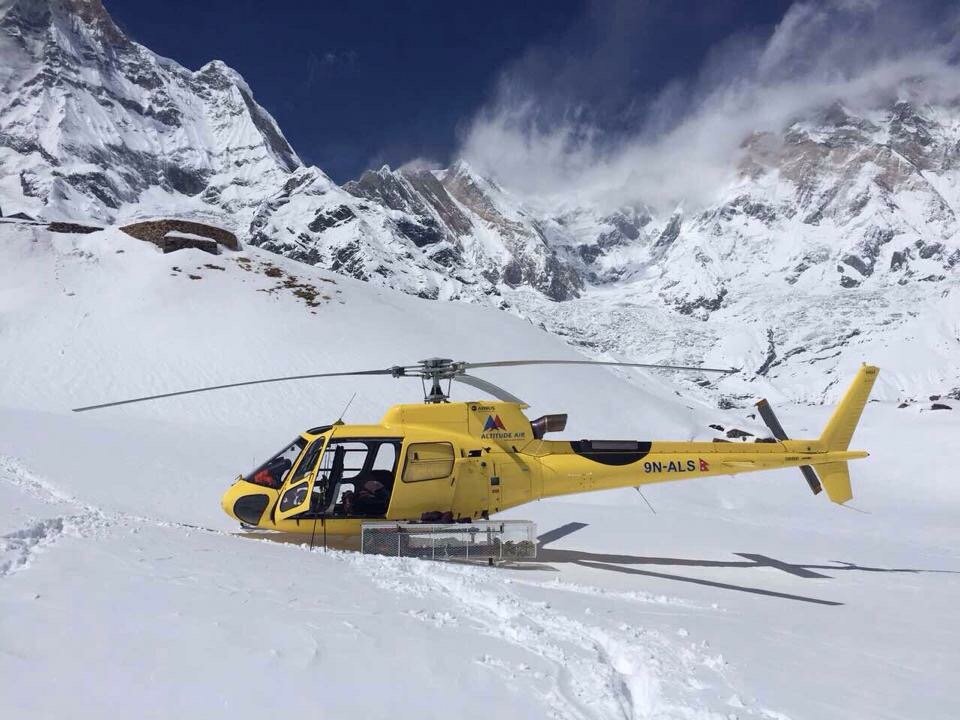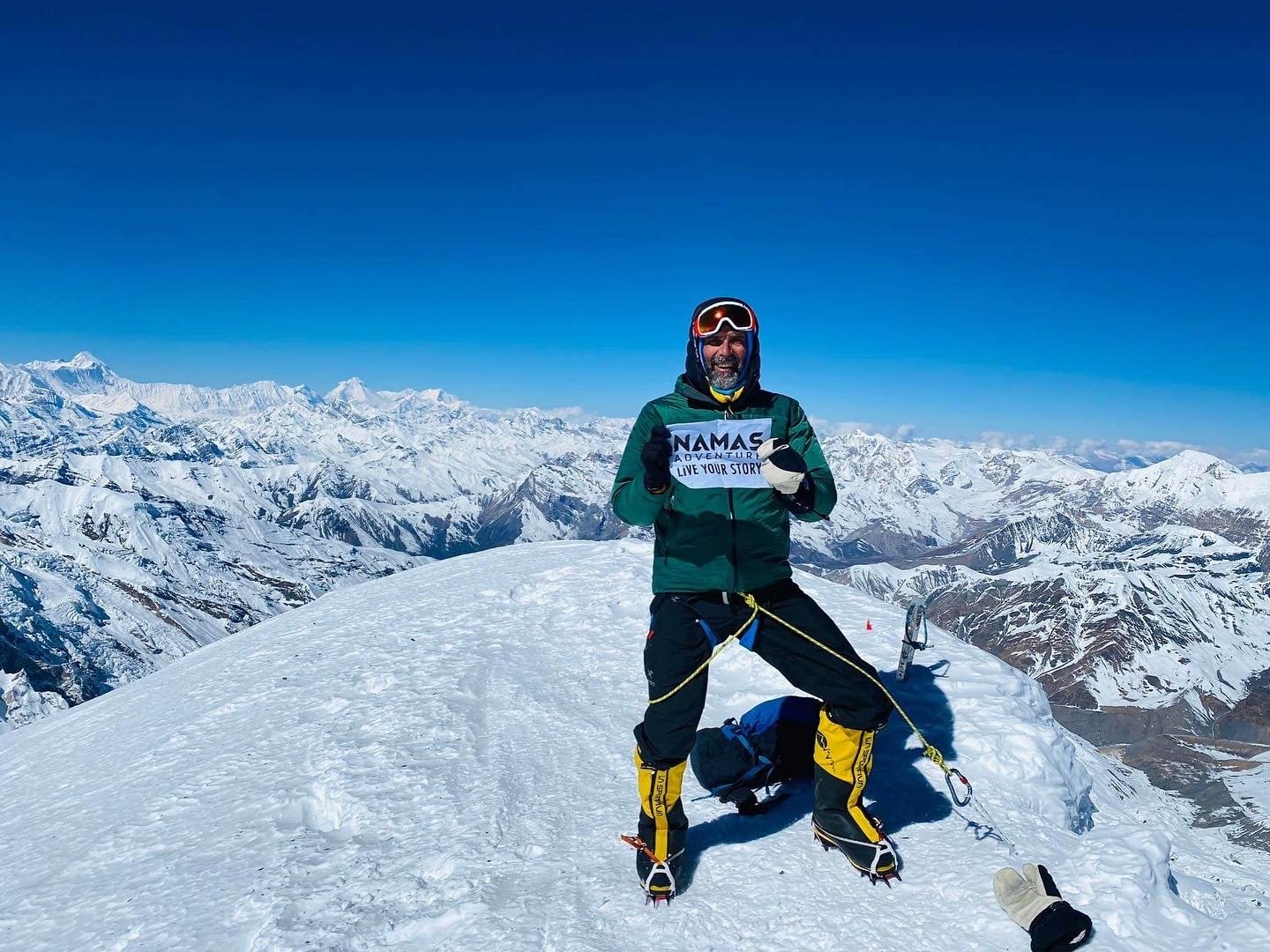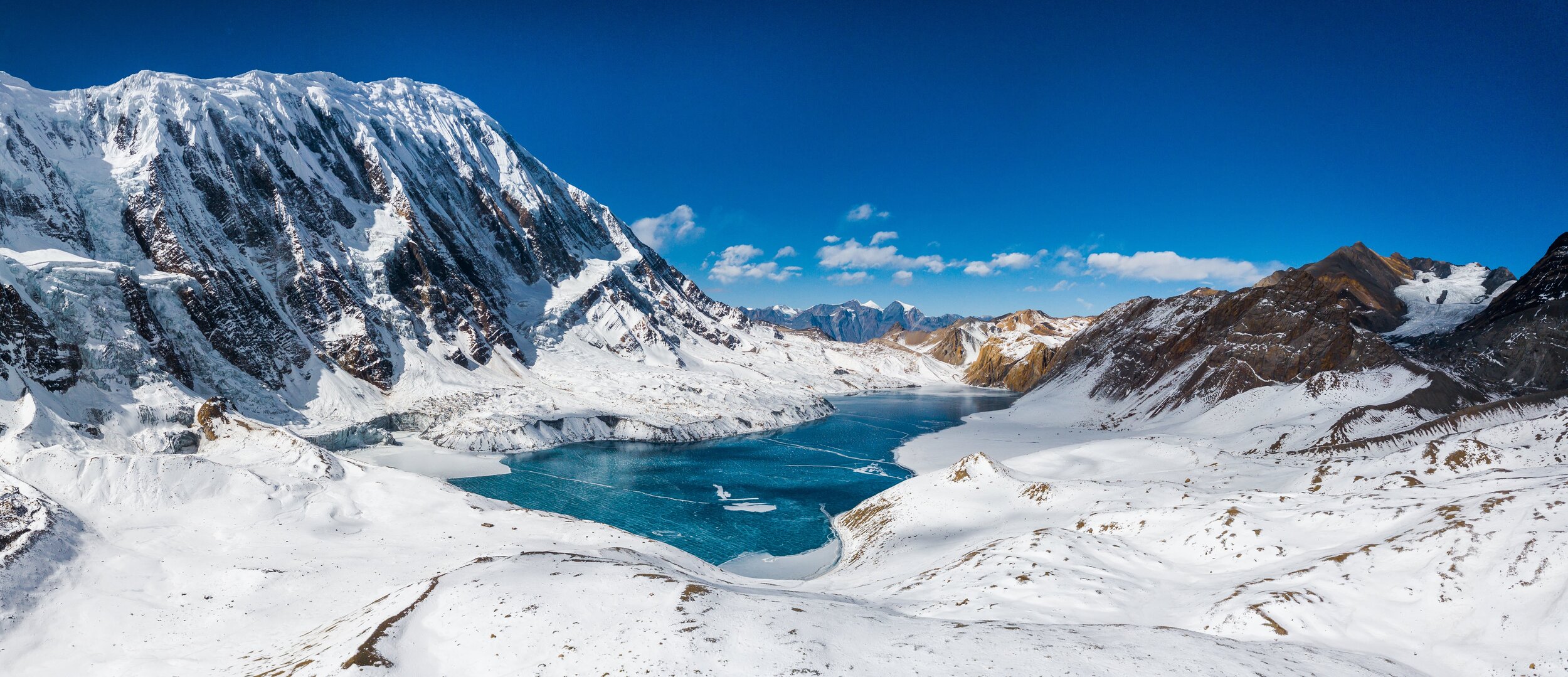Everything you need to know about Cholatse 6440M climbing expedition - Namas Adventure
Everything you need to know about Cholatse 6440M climbing expedition
Cholate expedition is considered the next stage of commercial climbing a technical peak in the Himalayas. This expedition is for climbers who are planning a technical challenge climbing at 6000M - 64000M altitude. Grade route WI2+ M3-4 A1-2. If you have climbed Ama Dablam or other technical peaks around the world at D+/-, 5.9/5.10 grade levels, then you can consider yourself qualified for the Cholatse expedition. This expedition is not for any beginner but rather for advanced-level climbers.
Although the Khumbu region is the most popular region amongst hikers and climbers, this area around the Gokyo region sees the least amount of visitors, and at the area where Cholatse/Taboche peak is located, there are almost no people in sight. Consider this a hidden gem to climb in the Khumbu region.
Everest or Khumbu region is the mecca for high altitude climbers and every year there is a flock of climbers into the region but Cholatse received fewer climbing teams which make it perfect for climbers who prefer fewer/uncrowded and technical climbing expedition. Also, preks f this expedition is visiting the beautiful Gokyo valley. A must-go destination, acclimatize at 5000M level and set yourself ready for a challenging expedition to Cholatse.
1. When is the best time to climb Cholatse Peak?
Cholatse is best suited to climb during two climbing seasons. Spring (Late March-May) and Autumn (September - November). During both seasons there aren’t as many climbers as other peaks in the Everest regions. So climbers can expect a low number of climbers.
For experienced climbers, winter climb is still possible but this comes with a lot of uncertainties. i.e unstable conditions, tea houses may not be operational or even the ones operating won’t be well-stocked. Pre-arrangements will have to be made but that will also depend on the number of climbers.
2. Is it possible to shorten the Cholatse expedition or what extensions trip are recommended?
Please contact our team for other extension options. (Inquire)
Extensions:
+ Ama Dablam 6810M (Additional 7 - 10 days) - Cost $6000 USD P/P
3. How much does the Cholatse expedition cost? What does the cost include?
The cost of the Ama Dablam and Island Peak expedition with Namas Adventure is $7250 per person for a 27-day itinerary and $9,500 per person for a 21-day express itinerary. Our team provides premium, all-inclusive services, including 1:1 climbing support, local guides who share their knowledge of culture and traditions, and a focus on safety, successful summit strategy, and top-quality base camp support. Our team is dedicated to being a responsible, ethical, and sustainable mountain adventure operator, so climbers can fully enjoy their climbing experience.
NNMGA Certified Sherpa Mountain guide
$500 Individual tip pool. Tip pool will be fairly distributed among all Namas staff members. (Guides, porters, drivers, hotel security, and staff). Guest may personally hand in extra tips to our guides and porters.
Namas Branded merchandise (Down Jacket, Cap, Buff)
1:1 Sherpa Guide: Client ratio
Cook and helping team at High Camp
40Kgs per person
Arrival hotel in Kathmandu
All trekking and climbing permits (Peak Permits)
All internal-local transportation to and from the trekking trailhead
Breakfast, Lunch, and Dinner on trek and expedition days.
1 Pot of hot water every night
Hydration tablet, frozen foods at BC and high camps
Lodge accommodation during the trek
Porters
Arrival pick up and departure
Internal flights
Basic First aid kit
Welcome/Farewell leave Dinner
4. Are guides necessary for climbing Cholatse Expedition?
To issue permits for the Cholatse expedition climb, you will have to go through a registered local company. With any commercial expedition, certified guides are a must. But for climbers of all advanced/pro levels, we highly suggest climbing the peak with local guides at least as a backup support crew up to base camp and for any emergency situations. Experienced climbers/guides who want to venture into new routes will still have to be assigned a local guide even if they don’t prefer them climbing with them. So, yes legally speaking guide assistance is required.
Even the usual southwest ridge climbing route does have several crevasses and new hazards may appear every climbing season. This is a very technical and challenging peak, so should not be taken lightly.
5. What is the best acclimatization itinerary for Cholatse expedition?
Cholatse southwest ridge route
For climbers, acclimatizing properly for high-altitude climbing trips is a must. Our expedition itinerary planning allows you to acclimatize to higher elevations, giving your body the time it needs to adjust to the altitude. With years of guiding experience and well-known scientific literature, we know that this is the only way for your body to adapt after gaining elevation. With that knowledge and experience, our team has built up the itinerary for this expedition.
On the Cholatse climbing trip, we make sure we have 1 - 2 rotations up to camp 1 so that we can get a feel of climbing. The first crux section in the mountain is the ice wall that leads to a steep ice headwall climbing up to 5700M where camp 1 is set up, this will also be our rotation strategy. Your body needs these adaptation periods when you are above 5000M+. This way you can acclimatize properly, experience alpine camping, enjoy the Himalayas all around you and be stronger to further push onto your summit bid.
6. What training is required for this expedition? Can you suggest me a training plan?
Cholatse climb is by no means an easy or comfortable climbing expedition. This expedition is not for the beginner or intermediate-level climbers. Also, climbers with only high altitude non-technical style experience will struggle in this expedition. This mountain will test you on every inch and will push you further in your technical climbing abilities.
Mountains are graded based on their technical and physical difficulties. For your training, we highly recommend climbers focus on endurance and strength/muscular training. Any type of aerobic exercise, like long-distance running (10-15km) 3 to 4 times a week, cycling (1 hour - 2 hours), hiking gaining elevation with 10-15kgs weights on are some of the suggested training. We can also suggest high-intensity training like cross-fits are a good way to build your overall fitness or kettlebell training are also suggested.
Technical climbing
With your technical climbing abilities for this expedition, you should be comfortable with the ice and mixed climbing. If you can climb anywhere above WI 2+, M 3- 4, and rock 5.4 + then these skills will be necessary for the mountain to overcome the obstacles. Ice and mixed climbing skills are a must for this expedition.
7. How hard is the Cholatse expedition climb?
Cholatse is graded at TD/5. (Alpine/fitness grading link).
climbing up from camp 1 - camp 2
Climbers are expected to be exceptionally fit. The day climbers leave from base camp to higher camps, the real expedition begins. Breathing is always a challenge at high altitudes but with proper acclimatization done ahead of time, staying well hydrated, eating properly, your body should recover and adapt to the altitude.
The first real crux starts through navigating the icefall and facing a steep 45 - 60 degree headwall on the west col of the mountain. Just above the ice headwall in the narrow areas of the rocky slab is where we set up camp 1. The most difficult section of the entire expedition is from camp 1 to camp 2. Lots of different styles of climbing on open exposed, unprotected loose rocky sections. Once you are over the rocky part of the climb another 500M vertical climb further on up the knife-edge ridge, crossing crevasses, ice walls, and uneven sections. There is no comfortable place to rest before reaching Camp 1. You can expect a long- tedious climb on this day. Expect to climb around 8+ hours which depends on your climbing ability, eventually to make it to camp 2.
Camp 2 to the summit is relatively short, about 250M but another super-focused day on climbing on knife-edge ridge with 1000M drop on either side. Climbers will have to navigate uneven ice walls and trails that pass through them, climbing over them to make it to the summit. Cholatse Summit is a small plateau, comfortable one for the group to rejoice their summit moment. Summit is only halfway done and you will have to descend down to camp 1. Since climbers will have used a lot of energy climbing up the mountain, they have to stay focused when abseiling down the same exposed steep mountain.
You can expect to climb around 10+ hours on this day as you will have to summit and then descend back to camp1. All your previous physical training, your will, mental strength, and your grit for real adventure will take you through this final day.
More in-depth details in our Cholatse Expedition page strategy.
8. What are the clothing and gears - boots required for Cholatse expedition (trekking and mountaineering)? Can I rent gears in Nepal?
Choosing the right gear is very important. We advise climbers not to make compromises on the quality of gears and clothing, and to pay attention to layer up comfortably as well. You will highly depend on your clothes to keep you warm, especially during nighttime when temperatures can go down to -10/-25. Please check our equipment blog for recommended clothing and gear.
Renting your gears in Nepal? We provide gear rentals exclusively for Namas Adventure clients during our climbs. All the gears are in the best condition, clean, and highest quality. Kailas equipment, black diamond, Mountain Hardwear provides all-out mountaineering gears. (Namas Equipment hire link)
If you want to hire it from other local sources in Nepal, our simple answer is NO. This is one of the most frequently asked questions. We have tested and tried several gears in Nepal and frankly, we do not recommend hiring here. We know it might seem like a huge amount of expenses to buy all the gears, but they are well worth it.
With better technologies, climbing shoes have improved every year. We highly recommend double-layered boots like La Sportiva G2 or Scarpa phantom. It is wise to spend on good mountaineering boots, as so with all the gears that we have mentioned in this post above.
9. What types of foods are available during the expedition? Is clean water available and how much water intake is recommended?
We suggest all our clients drink 4-6 l of water every day. Staying hydrated will also help you with acclimatizing properly. It’s best to take hydration tablets or filtration bottles with you.
Most of the foods are prepared in the tea houses and during your climbing days, kitchen tents are set up by our Sherpa teams. You do not need to worry about food but remember to eat enough. In the high altitudes, your body will naturally want to reject food or avoid using energy on anything, which includes eating too. You might have to force yourself with the first few couple of bites and then eventually your body will start accepting the food. We also provide packed dried meals, so that clients have other options should they not want to eat what’s being cooked in the tents.
Remember to avoid smoking and any alcohol intake. You might see our guiding leaders smoking or drinking but remember they are professionals and they have adapted very well to these environments compared to the climbers who go there just for adventure holidays.
10. What trip insurance will I need for Cholatse expedition? Do I need helicopter evacuation to be included in my insurance cover?
No matter how prepared you are, you never know when or how things might go wrong. You might be sick suddenly or not that we wish but there might be some incident, you might suffer from altitude sickness or anything we can’t imagine yet. So, for these reasons, it is always good to have insurance cover. Our recommended Insurance companies (link)
Helicopter evacuation is our final emergency option and we do recommend you have one in your insurance, as it is the only means of transport in the Everest region. Our guides will assess your condition and examine if it is a major issue. If not, they will use their experience to motivate and push you through your trip. However, in case of emergency, helicopter evacuation will be called upon.
There is a procedure to follow when calling for emergency evacuation. We will call the insurance company hotline, get approval with your insurance and only then helicopters are sent to the distress call location. You will have to pay for the evacuation in Nepal from your own pocket but once you are back home you can claim your money back. Make sure you collect helicopter evacuation receipts, certified doctor’s approval letter. The insurance company will ask for this evidence to back up your claim. There was a huge helicopter scam in Nepal during 2018, so insurance companies are taking extra measures to stop this from happening. Our guides and staff members in Kathmandu will also remind you of this process during briefings.
11. Which other high-altitude peak climbing can I aim for after Cholatse Expedition?
Recommended 7000M Expeditions
Once you have completed your expedition and when you feel like you want to take on higher peaks we can suggest other 7000M+ peaks that you can aim for.
HIMLUNG HIMAL 7126M EXPEDITION
Himlung Himal Summit 7126M
The south flank of North-west ridge route, Camp 1 - 3 strategy
7 - 13 days in Himlung Himal Base camp 5460M and higher
1:2 Guide/Client ratio throughout the expedition
Nar & Phu Villages and Manaslu conservation area
BARUNTSE PEAK 7129M EXPEDITION
Baruntse Expedition route
Baruntse 7129M summit, Mera Peak 6476M (Acclimatisation training peak)
South-east ridge route, Camp 1 - 2 strategy
5-10 days in Baruntse Base camp 5460M and higher
1:2 Guide/Client ratio throughout the expedition
Amphu Lhabtsa Pass 5800M and Khumbu Valley
TILICHO PEAK 7134M EXPEDITION (TECHNICAL CLIMB)
Tilicho Peak 7134M on the left.
Tilicho 7134M summit
North-West Shoulder ridge route, Camp 1, 2 and 3 strategy
7 - 14 days in Tilicho Base Camp 4910M and higher
1:2 Guide/Client ratio throughout the expedition
Tilicho Lake and Annapurna Circuit trek
Cholatse climbing is a must for any climbers who wish to push their technical abilities in the mountains. Granted it does not offer the charm of 8000M but the style of climbing needed during this expedition pushes you to your limits. We hope the information we have provided will help you decide or prepare for your outing in the best way possible. If you are looking for a great climbing trip and have an amazing time in Nepal, join us on our Cholatse climbing expedition! You can be assured that you are provided quality services with our fun-loving yet professional guides who have 5 - 10+ years of taking clients on such peak climbing trips. After all, we do aim to be the best adventure specialist in the world and you having a great time, being safe and summiting will always be our priority.
Do you plan to climb and summit the amazing Cholatse 6440M in Nepal? If you do have any more questions, please ask us below in the comment section or you can email us at bookings@namasadventure.com and our team will get back to you as soon as they can.
Challenge yourself. Dare great things. What’s stopping you?
GO. LIVE YOUR STORY








